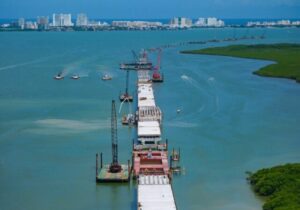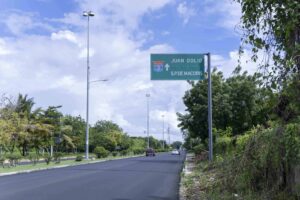Floods in the Brazilian state of Rio Grande do Sul They devastated almost everything necessary for economic activity, from local stores to factories, farms and ranches.
The environmental catastrophe, unprecedented in the history of the state, disrupted transportation, including the capital’s airport, Porto Alegre, which is expected to remain closed for months. Some sections of main roads are closed due to landslides, washed out roads and collapsed bridges. Blackouts continue to affect the state. The governor Eduardo Leite has said that Rio Grande do Sul will need a “kind of ‘Marshall Plan’ to rebuild,” although an exact strategy for doing so in a way that reduces future climate disasters has yet to be determined.
Gilberto Zeni, a merchant from Porto Alegre who has owned his store for 18 years, suffered enormous losses. “This has never happened before. “It is very sad to go through a situation like this after so many years of work,” said the 50-year-old man.
“But some people paid with their lives. This is a loss of material goods. Let’s rebuild. We are strong,” he added.
The scale of devastation may be more comparable to that of the Hurricane Katrinawhich hit New Orleans in 2005, said Sergio Vale, chief economist at MB Associates. He has wreaked havoc on services, production and sales, and many people are likely to lose their jobs, he said. Rio Grande do Sul’s economy, almost as big as Uruguay and Paraguay combined, had been growing at 3.5% this year through April, but could end 2024 with a 2% drop, according to his forecasts. That would mean a 0.4% reduction in the country’s gross domestic product, which is currently forecast at 2%. Bradesco expects a drop of 4%, which would mean zero growth this year.
:quality(85)/cloudfront-us-east-1.images.arcpublishing.com/infobae/ASELAMZ4RZ67APGHIWHL6HCYBQ.jpg 992w) Most of the 497 municipalities in the state have been affected and have serious financial losses (REUTERS/Adriano Machado)
Most of the 497 municipalities in the state have been affected and have serious financial losses (REUTERS/Adriano Machado)Most of the 497 municipalities in the state have been affected and the financial losses already amount to 10,000 million reais. ($1.9 billion), the National Confederation of Municipalities estimated earlier this month. About 94% of the state’s economic activity has been disrupted in some way, according to an estimate last week from the Federation of Industries of the State of Rio Grande do Sul.
“An infinite number of companies have seen their facilities completely disrupted. In addition to the huge financial losses, logistical problems will likely have a significant effect on all economic activity in the state,” he said in a preliminary study on May 13.
The most affected regions include Porto Alegre and the Serra region, northeast of the state, where vehicle, machinery and furniture factories. Heavy rains also hit the Río Pardo and Taquari valleys, known for their meat industries. Rio Grande do Sul represents 12.6% of the country’s important agricultural GDP, according to local bank Bradesco. Nearly 70% of Brazil’s rice and 13% of dairy products come from the state, according to a May 13 S&P Global report.
“It often takes 10 years for a flooded municipality to return to its previous level of economic activity,” said Gustavo Pinheiro, senior associate at climate change think tank E3G.
The human cost of the rains is at least 163 lives lost so far, with another 72 people still missing. More than 640,000 people have been forced to leave their homesincluding 65,000 who take refuge in schools and gyms.
Brazil’s federal government has announced a package of 50.9 billion reais ($10 billion) for employees, those receiving public assistance, the state and municipalities, companies and rural producers. But as time goes on and water levels remain high, the amount needed to rebuild continues to increase, Vale said. He estimated it could reach 120 billion reais ($29 billion).
:quality(85)/cloudfront-us-east-1.images.arcpublishing.com/infobae/22REOR2QOHEMXPOUXH5PHG25JY.jpg 420w) The most affected areas include Porto Alegre and the Serra region (REUTERS/Amanda Perobelli)
The most affected areas include Porto Alegre and the Serra region (REUTERS/Amanda Perobelli)While the total needed is still unclear, the cost to the federal budget is because public debt as a percentage of GDP has been rising, which could make Brazil less attractive to investors.
Carla Benian economist at the Getulio Vargas Foundation, a think tank and university, said that this should not be blamed on the flooded region.
“The federal government cannot refrain from supporting a state that was completely devastated just because the financial market thinks there is a fiscal risk,” Beni said.
Heavy rains that caused flooding can largely be attributed to human-caused climate change, according to an assessment published May 10 by ClimaMetera climate modeling scientific team at Paris-Saclay University in France.
This month’s flood was the fourth that Rio Grande do Sul suffered in a year, after the floods of July, September and November 2023 that They killed 75 people in total. Since 2000, flood-related disasters around the planet have increased 134% compared to the previous two decades, according to a 2021 report from the World Meteorological Organization. Countries have invested in huge infrastructure projects to prevent flood damage.
After Hurricane Katrina, the federal government spent $14.5 billion in bombs, levees and walls to protect New Orleans, leading to a significant reduction in damage caused by Hurricane Ida in 2021. Tokyo authorities spent billions on an underground drainage canal in the metropolitan area. Others promote the concept of “sponge cities”, whose objective is to transform urban areas into natural parks that improve drainage and reduce the risk of flooding.
:quality(85)/cloudfront-us-east-1.images.arcpublishing.com/infobae/3X2TVVW7AXM73MYVHWKF6ZTV44.jpg 420w) The heavy rains that caused flooding can largely be attributed to man-made climate change (REUTERS/Amanda Perobelli)
The heavy rains that caused flooding can largely be attributed to man-made climate change (REUTERS/Amanda Perobelli)On Friday, the president Luiz Inácio Lula da Silva signed a law that suspends payment of Rio Grande do Sul’s debt for three years. Funds that would have repaid the debt to the federal government should instead be used to combat and reduce flood damage. Finance Minister Fernando Haddad said his ministry will help the state’s large companies recover.
However, long-term success will depend on global decisions, especially the burning of coal, oil and gas that is driving climate change. Scientists and energy experts have long drawn up roadmaps (solutions) to reduce greenhouse gases like carbon dioxide and methane that are warming the planet and making climate disasters more frequent. And there is hope on the way forward, the International Energy Agency said in its World Energy Outlook 2023.
At the same time, the State will need to rebuild itself in a way that reduces vulnerability. Rio Grande do Sul built dikes after the massive floods of 1941, but this year they proved insufficient due to lack of maintenance. A group of experts has already called for stricter flood control. Homes and businesses may also need to be relocated away from the coast and river banks.
Rio Grande do Sul politicians and the federal government are also clashing over crisis response and reconstruction. While the leftist government studies a possible canal to accelerate the flow of water from the Patos lagoon to the sea, the center-right Leite has said that The project would be “very difficult to carry out” and could cause damage to ecosystems, the newspaper reported Or Globe.
The state must pass legislation that protects the environment, said Beni, an FGV economist.
“Climate denialist policies that favor the dismantling of environmental laws exact a high price“, he claimed. If nothing is done, he stated, “Rio Grande do Sul will experience these tragedies every two or three years. “There will be no time to rebuild before it floods again.”
Source: Infobae




